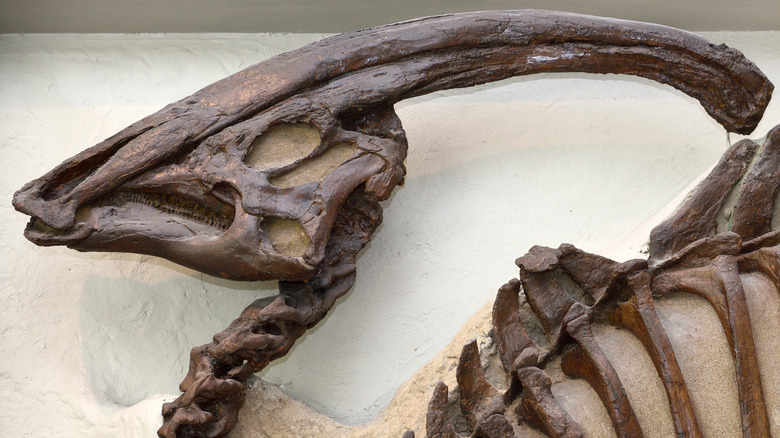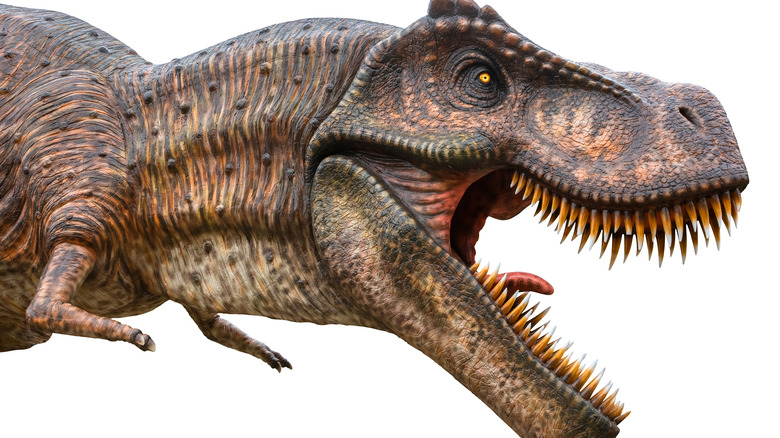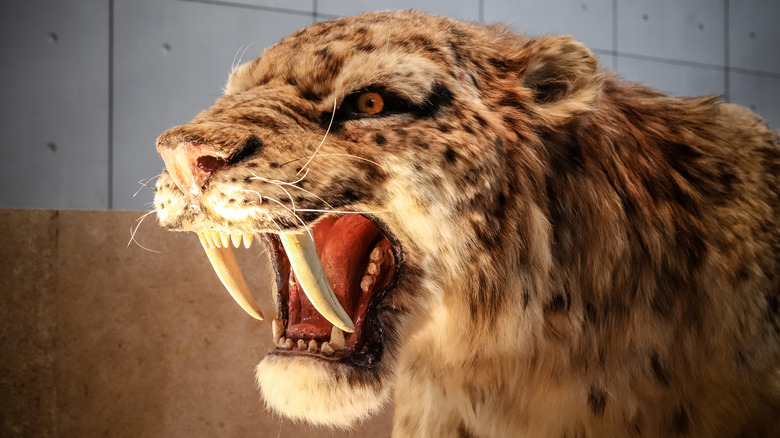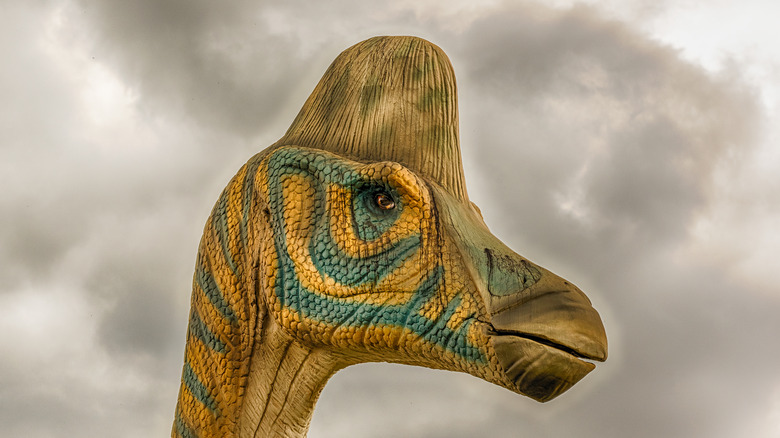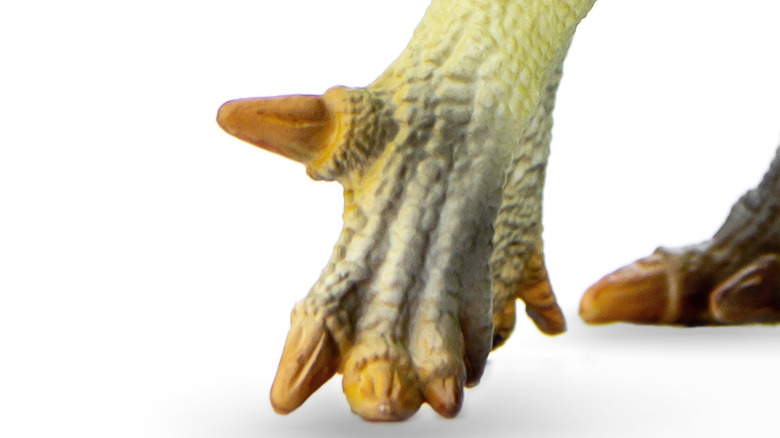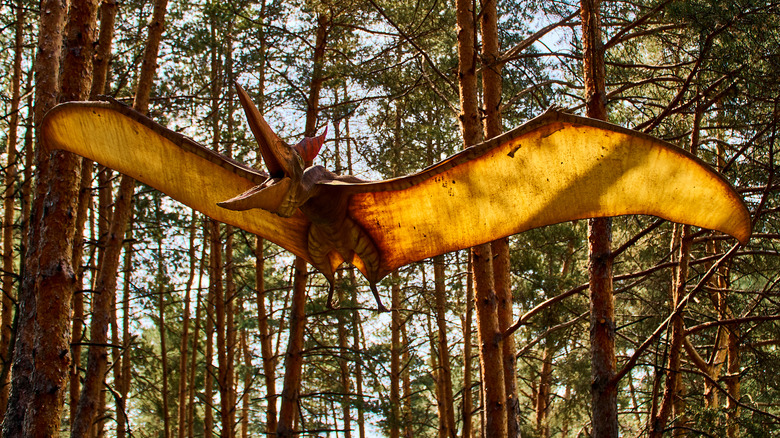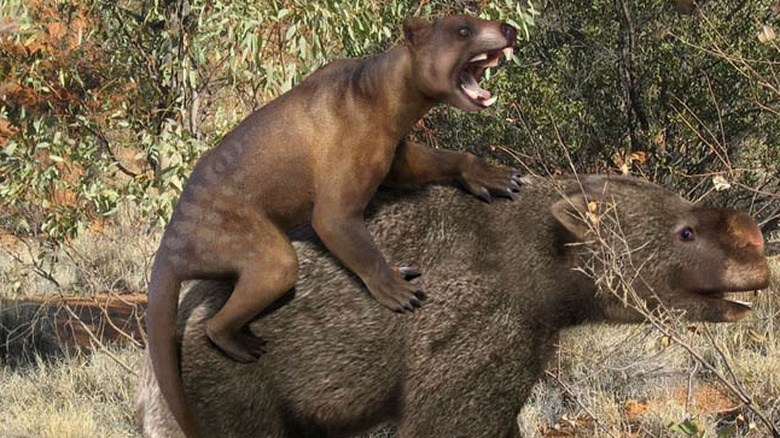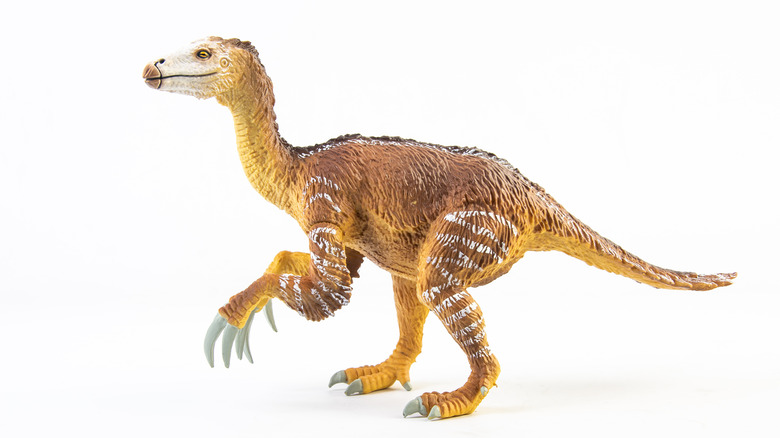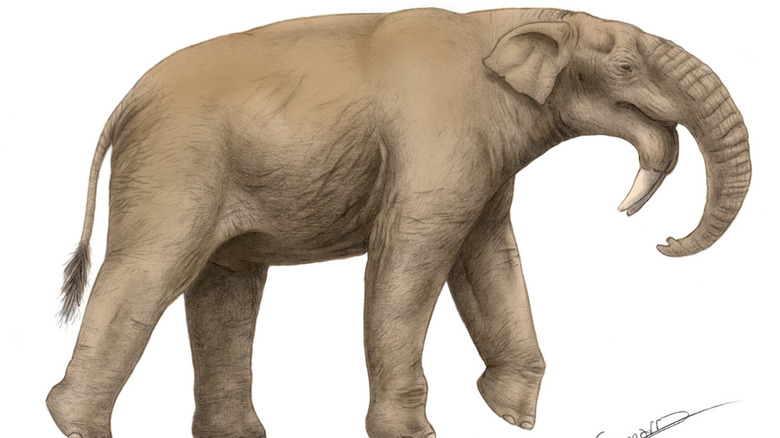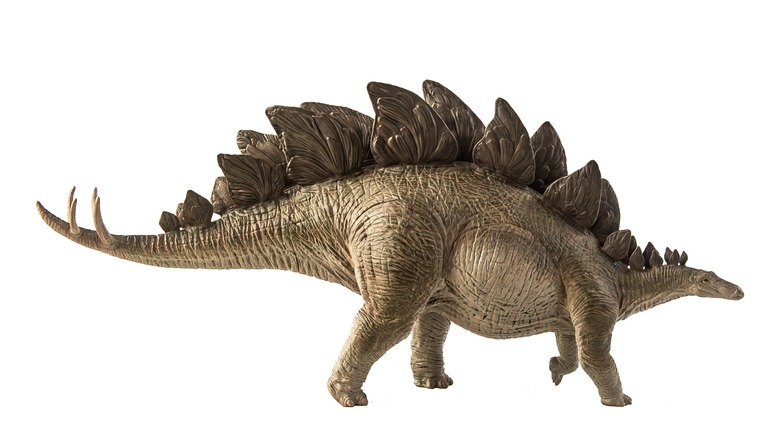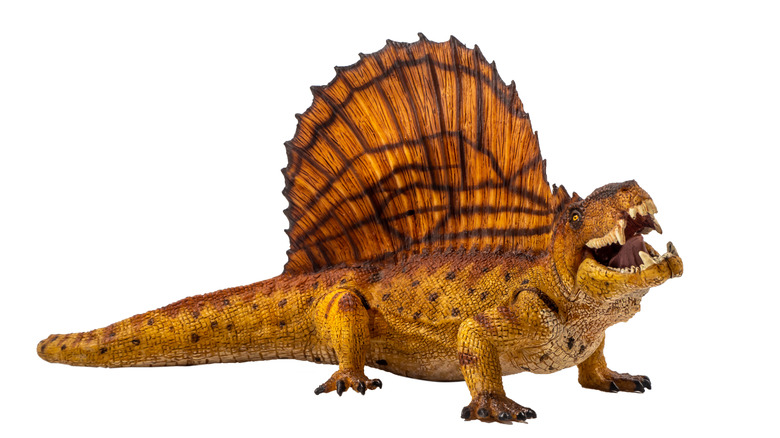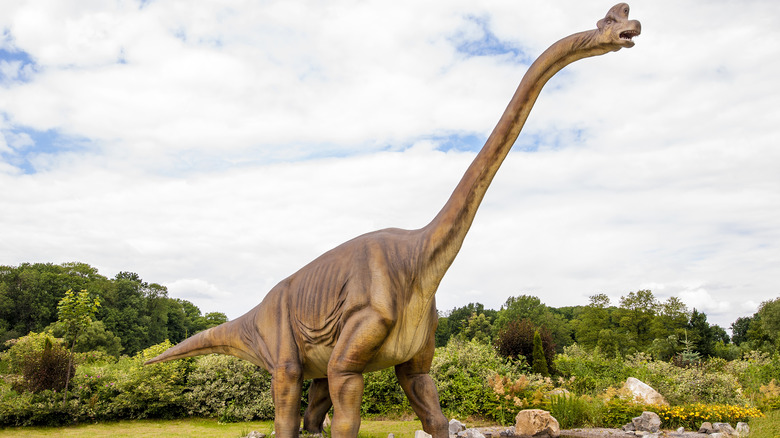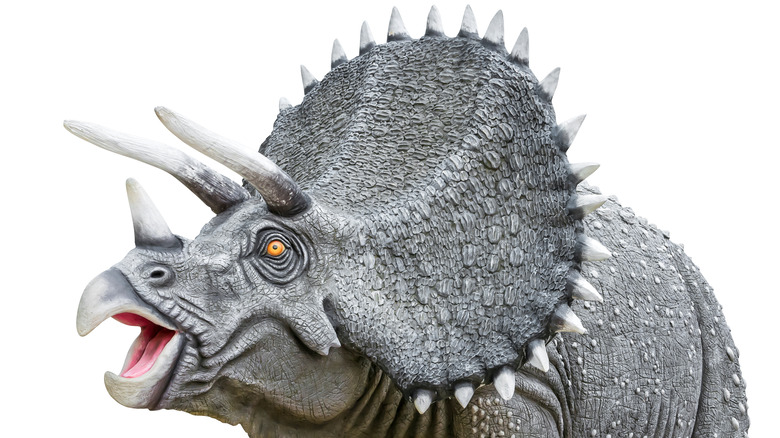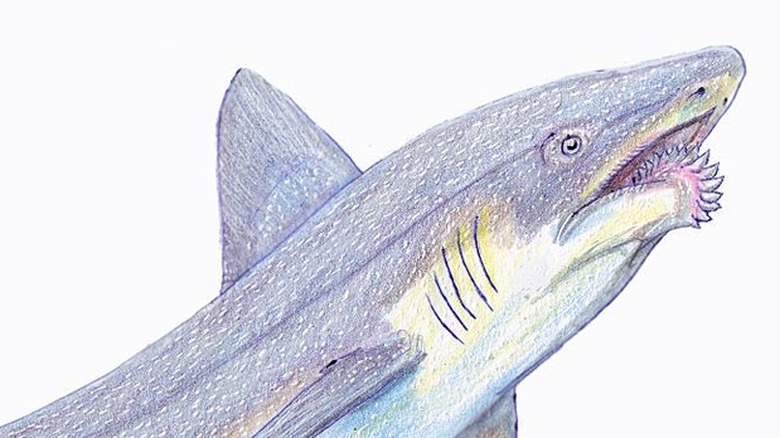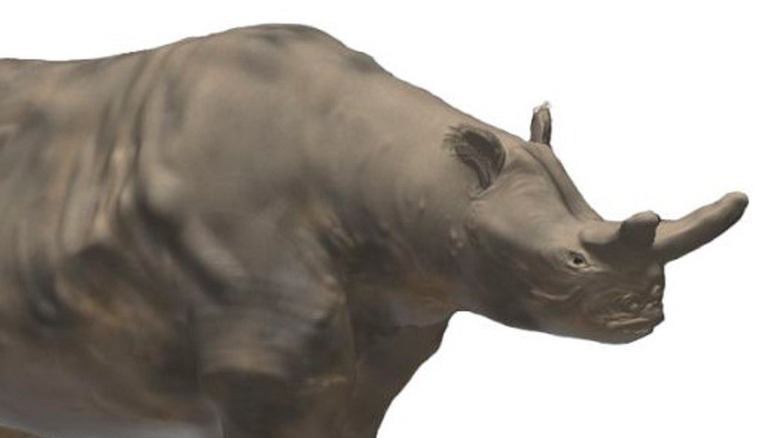Unique And Curious Features Of These Extinct Animals Explained
Imagine, if a million years from now some space alien paleontologist landed on Earth and started digging. Perhaps it would discover some strange, fossilized creature that seemed to walk upright on two limbs but also had two forelimbs with strange, five-digit structures at the end. "What did these things use this for?" the space alien may muse as it turns the fossilized hand over and over in its purple tentacles.
Go back a million years to today and you can appreciate the challenges paleontologists have when trying to decipher life in the past. As the Guardian points out, fossils are more often than not a jumble of hard parts turned to stone that have to be pieced together like a jigsaw puzzle. What makes it more frustrating is that very rarely do soft parts survive a fossilization process. Things like organs and coloration have to be guessed about based solely on the bones.
This has led to debate among scientists as to the purpose of some curious features that isn't readily explainable. Hypotheses are offered and routinely shot down by new theories that, while supportable, are never completely provable (unless you had a time machine). Let's take a look at some curious features of a selection of extinct animals which will better show you the hits and misses of working with stone and bone.
Tyrannosaurus arms
The Tyrannosaurus rex is undoubtedly the most famous of all dinosaurs. Its proportions, as detailed by National Geographic, are terrifying: eight tons, 40 feet long, and as big as a school bus with eight-inch serrated teeth that could crush the vehicle, too. This creature, one of the most well-studied of extinct animals, has often been puzzled over for an incongruous feature – its arms.
For such a large animal, the arms of the Tyrannosaurus rex are disproportionately small and stubby, being only about a yard long and featuring four-inch claws. How could such a beast use them? This problem has been debated for decades. Some paleontologists say that the arms are merely vestigial, such as how flightless birds have tiny wings. Others have suggested that the predator used its arms to push itself off the ground. Then some say that it practically helped the Tyrannosaurus by letting it latch onto animals at close quarters or perhaps latching onto a mate. More recently, scientists have noted that even though the arms were small, they were powerful and can be used as slashing weapons that could open large gashes. Criticism and commentary for each potential use of the arms makes each use almost as likely as the next. What is clear is that the debate over Tyrannosaurus's forelimbs is to continue with ever more creative purposes.
Smilodon canines
One of the most well known extinct mammals is the Smilodon, which was part of a larger group called the saber-toothed cats. As described by How Stuff Works, these creatures featured enormous canines that were used to take down prey. These teeth looked like huge chef knives dangling down below the great cat's jaw. Kitten Smilodon's weren't born with their teeth fully formed. The animals were born with baby teeth which were then replaced with these sharp bananas. These cats were also larger and stronger than modern big cats, weighing up to 750 pounds, putting them well above even Siberian tigers. The Smilodon and all other saber-tooth cat species went extinct about 10,000 years ago. Reasons for their extinction include human hunting and climate change.
The debate has been over how these predators used its saber teeth. The University of California's Museum of Paleontology states that some paleontologists thought that these cats used the canines to grasp and hold prey. This theory has been largely criticized by other scientists who noted that the saber teeth would easily break if used in this manner. This has been corroborated by the fossil record which shows that the teeth were rarely broken. Supporting this view is that the cat was not built to hang onto prey with the canines. A more likely use was that they were used to inflict a massive stab wound. The cat would then wait for their victim to expire.
Hadrosaur headgear
The hadrosaurs, commonly called duck-billed dinosaurs, have one of the most unique features known among extinct animals: blingy headgear. There were several species of these creatures including, as described by National Geographic, corythosaurus, parasaurolophus, and lambeosaurus. Most had different forms of stylish head crests. For example, corythosaurus sported what looked like a mohawk-like helmet on its head while parasaurolophus had a swoop-back swoosh structure.
The question among scientists has been what was the purpose of all these structures. Since these were too fragile to serve a defensive purpose, other theories have been offered which have been documented by Live Science. Some offer that it somehow was tied into olfactory reception and improved the animal's sense of smell. Others theorized that it allowed for sound to resonate or even to regulate temperature. Then of course they could have just been used for display. Recent research seems mostly to support that it served the dual purpose of display coupled with sound resonation. This theory is backed by the fact that passages in the structure traveled to the nasal cavity, but that brain scans have shown that it was not necessarily tied to the sense of smell.
What is interesting is that for display, National Geographic suggested that the crests were more elaborate than originally conceived with perhaps coxcombs and other soft structures which don't preserve well as fossils.
Iguanodon thumbs
In the early 19th century, our understanding of dinosaurs really took off with the discovery and classification of fossils. As Smithsonian describes, in 1825, one fossil was found and dubbed "iguanodon." One piece of the findings was a conical fragment. Was it a tooth? A horn? At first, scientists assumed these were spikes on the nose. In fact, as reported by the U.K.'s Natural History Museum, the first replicas created of dinosaurs in the mid-19th century for an exhibition at the famous Crystal Palace depicted the animal with a horn on its nose.
However, these horns were not horns. A later fossil showed that they were in fact spikes for where the thumb would go.
Since then, scientists have pondered on how just a digit could be used. One of the earliest theories was that it was used for defense, though this has been highly criticized as being impractical — consider wielding a pen knife against the slicing teeth of a theropod. Other theories are just as unlikely — use as a seed or nutcracker or to strip branches. Yet perhaps the most outre – or at least darkly whimsical — suggestion, was that it was used to deliver poison. In all respects, the Iguanodon thumb spike will continue to be a source of speculation for paleontologists for years to come.
Pterosaur pycnofibres
It was furry and it flew. If you are thinking it was a bat, guess again, since this extinct group of animals had species that could get as large as a cessna. Pterosaurs were the first flying vertebrates. According to Britannica, these creatures first appeared in the Late Triassic some 229 to 200 million years ago as a branch of the "archosaurs," or ruling reptiles which included their cousins the dinosaurs. Pterosaurs evolved to fly on membranes that grew out of a much elongated fourth finger. These animals grew steady throughout the Mesozoic era and reached their largest size with Quetzalcoatlus which, with a 40-foot wingspan and over-8-foot beak, is described by National Geographic as being "as large as a giraffe."
Aside from their size, one of the most unique features of pterosaurs is a fur-like covering called pycnofibres. These, according to Sci News, were considered the equivalent of mammalian fur or feathery down, but evolutionarily different. Recent research, however, has changed some of these views. Recent fossil findings have suggested that the pycnofibres may in fact be a form of proto-feather rather than a separately evolved trait. If that is the case, then this would upend assumptions about the evolution of feathers, showing that they had developed much earlier by a common ancestor of both dinosaurs and pterosaurs.
Marsupial lion claws
Marsupial lions of Australia were of the fiercest animals that you probably didn't know existed. The Thylacoleo carnifex was reported by National Geographic as being up to 350 pounds and roughly the size of a leopard. This made it the largest marsupial predator ever. Its describer, Sir Richard Owen, wrote in 1859 (as recorded by the Australian Museum) that Thylacoleo was "one of the fellest and most destructive of predatory beasts." Thylacoleo, terrifyingly enough, lived until the time of human migration into Australia. There are even depictions of it in cave paintings.
How Stuff Works explains that this fell beast had some puzzling details. It had blunt teeth that worked with powerful jaws (the most powerful bite of any mammal ever). It also had impressive forelimbs which suggests that the animal earned its meals by ambush. It had long been supposed that the Thylacoleo had done the job similar to methods used by today's big cats by holding prey with its claws and biting on the neck. However the design of the claws, which features a wicked retractable, semi-opposable dew claw, did not align with how feline claws are used. It also did not explain why the teeth were blunt when sharper teeth would more easily kill. Recent scholarship published in Paleobiology offer a reverse explanation that may solve this puzzle. Thylacoleo may have used its blunt teeth to hold the prey while its enormous dewclaw slashed and disemboweled the animal to death. Messy, but effective.
Therizinosaurus Claws
Therizinosaurus was one of the weirdest dinosaurs to ever roam the earth. This animal, which, according to National Geographic, lived in Central Asia during the late Cretaceous between 70 to 75 million years ago, was some 33 to 39 feet long, awkward looking, and probably bipedal, being a theropod (related to Tyrannosaurs).
Yet what made Therizinosaurus most bizarre was its ultra long claws — perhaps the longest ever. These suckers apparently get up to 3.2 feet in length with three at the end of each forelimb. It would be as if Edward Scissorhands teleported to Jurassic World and had offspring with a velociraptor.
Therizinosaurus is still a mystery to paleontologists. However, they think they figured out the claws. These were not used to take down prey. In fact, as Britannica relates, despite being a cousin of meat eating dinosaurs, it is likely that Theriznosaurus was a herbivore. The claws were most likely used to bring down branches for food and to defend itself.
Deinotherium tusks
The Deinotherium was essentially a very large elephant with a slightly shorter trunk and backward tusks. According to National Geographic, this proboscidean lived from about 14 million to 1 million years ago, and instead of having tusks in the upper mouth that curled upward had two tusks in the lower mouth that curved downward. Why was this?
Older theories suggested the 10-ton animal was an evolutionary dead end when compared to modern elephants. But the fact that this animal lived for so many millions of years suggests otherwise. It is still unclear how the animal used the tusks. However, as "Life Through the Ages" argues, they were worn out enough to show that they were used practically and were not just for show. One theory is that the animal used its tusks to dig, much like a hoe. Another theory is that it used it to strip bark off trees or even pull them over. They could also have been used for fighting. It seems that this animal, which probably became extinct due to a combination of human hunting and climate change, will remain a mystery for at least a little longer.
Stegosaurus plates
The stegosaurus is an iconic dinosaur that is well known for its spiked tail and double row of plate-like structures running down its back. The defensive purpose of the tail spikes is a no-brainer, but as Smithsonian explains, the reasons for the plates are still a puzzle for paleontologists. Early theories, such as they were used for defense, don't hold up to logic. While the plates may offer some feeble protection for the back, the rest of the animal was exposed. Besides, the spikes might do a more effective job at protecting the dinosaur from a hungry allosaurus. Another old argument was that the plates were there to regulate heat. The way it would work is that by turning the plates broadside to the sun in the morning the dinosaur could warm up and when too hot could turn toward the sun to cool down. While research has shown that the plates could do that, it doesn't seem to satisfy the question as to if that was what they were really for.
Scientific American reports that the most accepted theory argues that the stegosaurus's plates were there because they looked cool. That is, these structures were used for display. One of their supporting arguments is that other stegosaur species of the order have smaller plates which would provide only a negligible contribution to heat regulation. Whether they were used for display in mating behaviors or if they were simply to recognize one another is still unknown.
Dimetrodon sail
One well-known prehistoric reptile, based entirely on its outlandish looking sail, was the dimetrodon. As noted by Britannica, these nearly 12-foot long creatures roamed the Earth during the Permian Period between 270 to 286 million years ago, predating even the dinosaurs. Now, as for the "sail" that ran down the center of its back, these were elongated vertebrae that were covered by a membrane.
The sail feature is often thought of to be a way to regulate the animal's heat if the membrane had blood vessels in it. It would be a good way to gather solar energy to warm the body, and likewise, the wide structure could allow easy heat dissipation. However, a more recent theory published by BioOne Complete theorizes that the sail may have been essentially a large battery because, through examination, they claim that there were not enough blood vessels in the sail to perform essential heating and cooling functions. Rather, it could have stored energy that was needed for quick bursts of speed, such as when dimetrodon chased prey. Currently, the heat regulation theory is still favored by experts.
Sauropod necks
Sauropods, which includes such animals as brachiosaurus, diplodocus, and brontosaurus, are known for their enormous size and their extremely long necks. For example, Britannica states that the Dreadnoughtus, which is the largest sauropod whose size can be calculated accurately, was 85 feet long from head to tail and weighed 65 tons. The neck itself was 37 feet long.
The sauropod neck is an immense biomechanical problem that scientists have puzzled over since they were first discovered. National Geographic reported that any animal of that size would need an immense heart and incredible blood pressure. If the sauropod used its neck to crane up to the tops of trees for browsing then its blood pressure would need to massively increase to allow fluids to flow to its brain. Conversely, if it wanted to have a drink at a stream, its body had to lower its blood pressure so that it didn't pass out. It is supposed that these animals had valves and shunts to slow or increase blood flow to the head, much like long-necked animals like giraffes have today. While there is no direct evidence of these types of adaptations since soft tissues usually do not fossilize, they definitely did something since they obviously could move their necks in those ways.
Triceratops neck frills
Triceratops is the usual herbivorous dinosaur which artists like to put into battle with Tyrannosaurus rex. Like all good warriors, Triceratops had its shield in the form of an ornate head frill. But were these frills really used for defense?
The Triceratops was one of many species of ceratopsians, which, according to the U.K.'s Natural History Museum, were a group of animals which usually, but not always, sported horned faces and neck frills. The triceratops is one of the largest of the group weighing at over six tons and is undoubtedly the most famous. While the purpose of its lance-like horns is obvious, the neck frill is not.
The frill looks like it is in place to defend the neck from a bite. According to National Geographic, it was composed of bone and also featured small spikes called epoccipitals. And while it certainly offered some protection, it was weak. Fossil evidence has shown tyrannosauruses chomping right through the frill. Another early theory, body temperature regulation, has also been discounted. The most commonly accepted theory now is that they were used to attract mates. The frills grew in size as the animal matured and was probably used to flag oneself as a healthy, viable mate. However, this is probably not the last word on the matter. As the paleontologist David Hone said, "Almost every hypothesis for their frills and horns is plausible in maybe a couple of species."
Helicoprion teeth
The Helicoprion is truly an evil-looking creature that is the stuff of nightmares. As National Geographic details, this 25-foot underwater predator swam the sea 270 years ago with a set of teeth that can best be described as a circular saw. When first discovered in 1870, paleontologists at first thought the creature was related to shelled nautiluses, but they soon realized the thing was a fish. Since the first fossils of Helicoprion did not show the teeth in the correct position, decades of speculation followed, placing the teeth at the snout and other places. When it was finally placed correctly, it was still inexplicable. The lower jaw had this whorl of teeth while the upper jaw had none. So how did it catch its prey?
Scientists still — and will most likely continue to — puzzle over this question. The best theory offered so far is that it truly worked like a saw. As detailed by Scientific American, as a prey item came into contact with the teeth, it rotated backwards and into the mouth. This would be an effective strategy against soft-bodied animals like squids.
Brontothere horns
Brontotheres looked sort of like rhinoceroses, but these large North American mammals were unrelated. The National Park Service relates how these large creatures roamed North America during the Eocene some 38 to 34 million years ago. Indeed, these animals were roughly the size of a large rhino or bigger. What really creates confusion is the curious double joined blunted horn at the tip of the Brontothere's snout. These structures were not, as explained by the San Diego Natural History Museum, the keratin that rhino horns are made of, but rather bone. Later specimens even developed prong-like horns on the neck.
What were these horns used for? The first offered theories suggested that the animals engaged in head on collisions in contests of dominance, such as bighorn sheep do today. However, this is unlikely since research has shown that the horns would probably break in such a collision. A more accepted theory suggests that the horns, in combination with powerful neck muscles would allow the animals to wrestle and club one another in side to side contests of domination.
